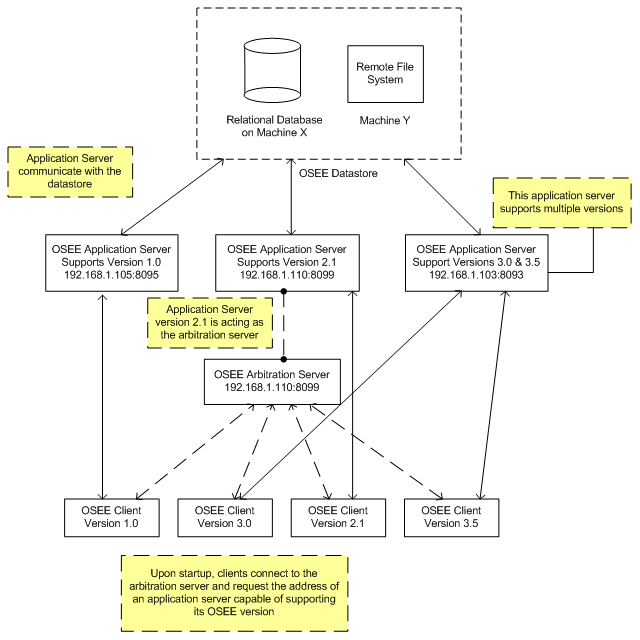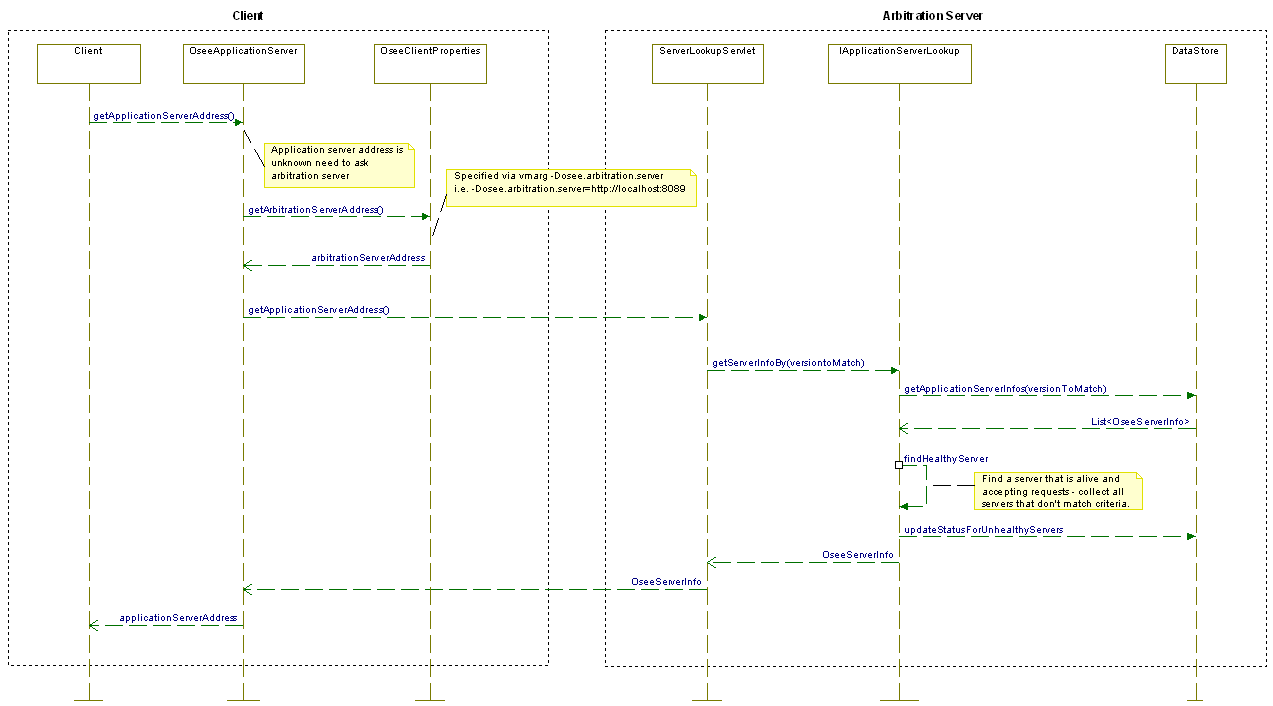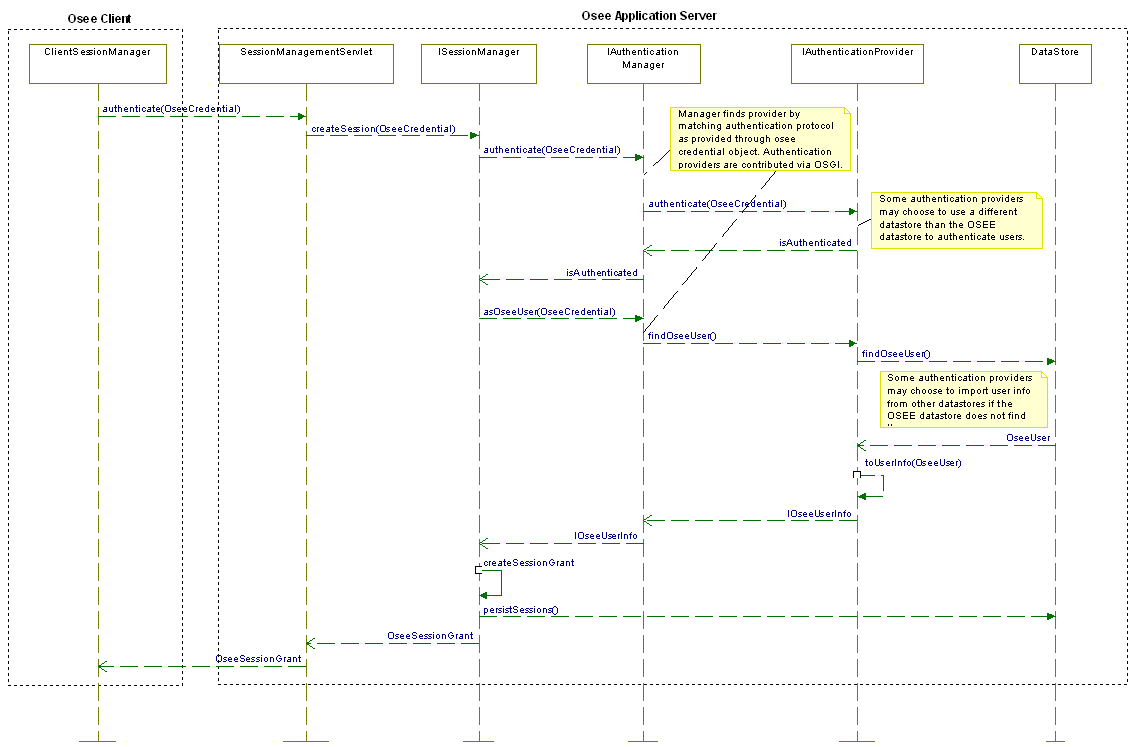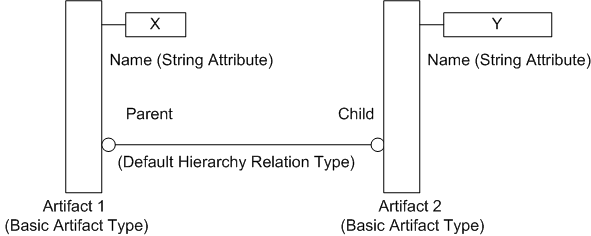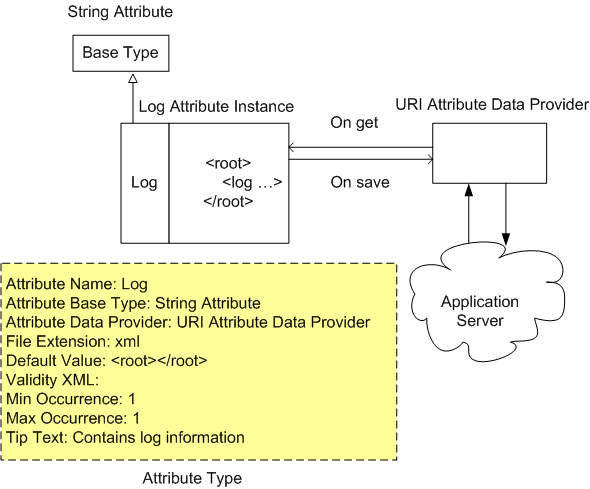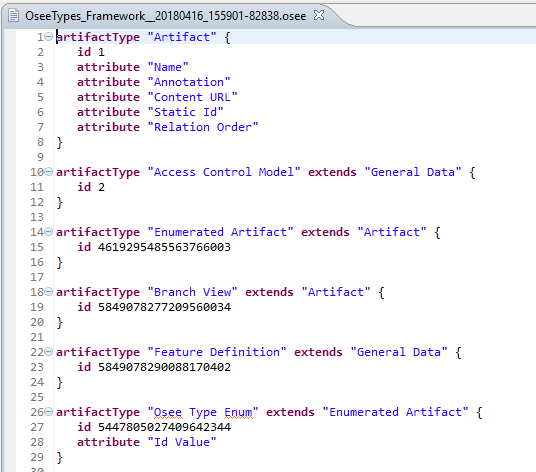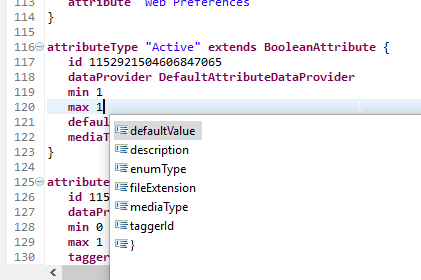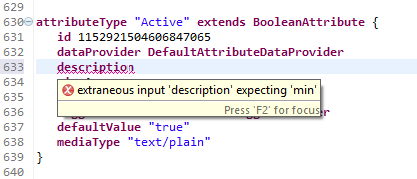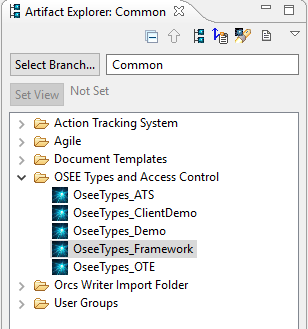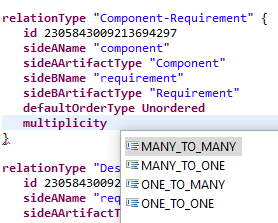Notice: This Wiki is now read only and edits are no longer possible. Please see: https://gitlab.eclipse.org/eclipsefdn/helpdesk/-/wikis/Wiki-shutdown-plan for the plan.
OSEE/Developers Guide
Contents
- 1 Architecture
- 2 Configuration Properties
- 3 Custom Data Model
- 4 OSEE Branches
- 5 Workspace Setup
- 6 Downloading and Configuring Eclipse
- 7 Working with GIT
- 7.1 Process for completing changes
- 7.2 When making multiple commits that need to look one
- 7.3 Before pushing to review
- 7.4 Push to review
- 7.5 If there are comments/changes needed based on reviews
- 7.6 Merge changes
- 7.7 After committer has merged changes and it is verified that they work
- 7.8 When you want to reset repo to head (ok with losing changes)
- 7.9 purging a branch- USE WITH CAUTION
- 7.10 How to push only one commit of a stack of commits
- 7.11 git notes
- 8 Testing
- 9 Location of OSEE Bundles
- 10 Migrating Branches to Another OSEE Database (including from previous OSEE version)
- 11 Fully Purge Branch and its backing data
- 12 Configuring ATS for Change Tracking
- 13 Custom OSEE Operations using BLAM
- 14 Event Handling
- 15 Use Cases
- 16 Building OSEE using Tycho/Maven
- 17 How to Define Classes for Coverage Importing
- 18 Using and Updating Swagger
- 18.1 Browsing/Utilizing The Swagger Web Application
- 18.2 Multiple Definitions
- 18.3 Servers
- 18.4 Searchable Tagging
- 18.5 Generating/Updating The Definition Files
- 18.6 Adding New Endpoints To An Existing Swagger Annotated Class
- 18.7 Adding A New Swagger Annotated Class To A Swagger-Aware Package
- 18.8 Referencing An Existing Package To Be Included In Swagger Scanning
- 18.9 Generic Versus Explicit Tagging
- 18.10 Parent/Child Annotated Path Limitation
- 18.11 Common Swagger Annotations
- 19 OSEE Web Development
- 20 Helpful links
- 21 Design Questions
- 21.1 I have strange eclipse/osee issues can I delete stuff from my configuration folder?
- 21.2 Is OSEE an application framework or an application?
- 21.3 Other products sound similar. Why OSEE?
- 21.4 Is OSEE only for Avionics Engineering?
- 21.5 What is Skynet?
- 21.6 What are Artifact Framework types?
- 21.7 What is the Action Tracking System (ATS)?
- 21.8 Why build yet another bug tracking tool like the Action Tracking System (ATS)?
- 21.9 How does OSEE handle traceability?
- 21.10 What is Define?
Architecture
Client Architecture
The central feature of OSEE is an extensible framework called the OSEE Application Framework. Default applications distributed with the OSEE framework are OSEE Define (for requirements management) and OSEE ATS (the Action Tracking System, for configuration management).
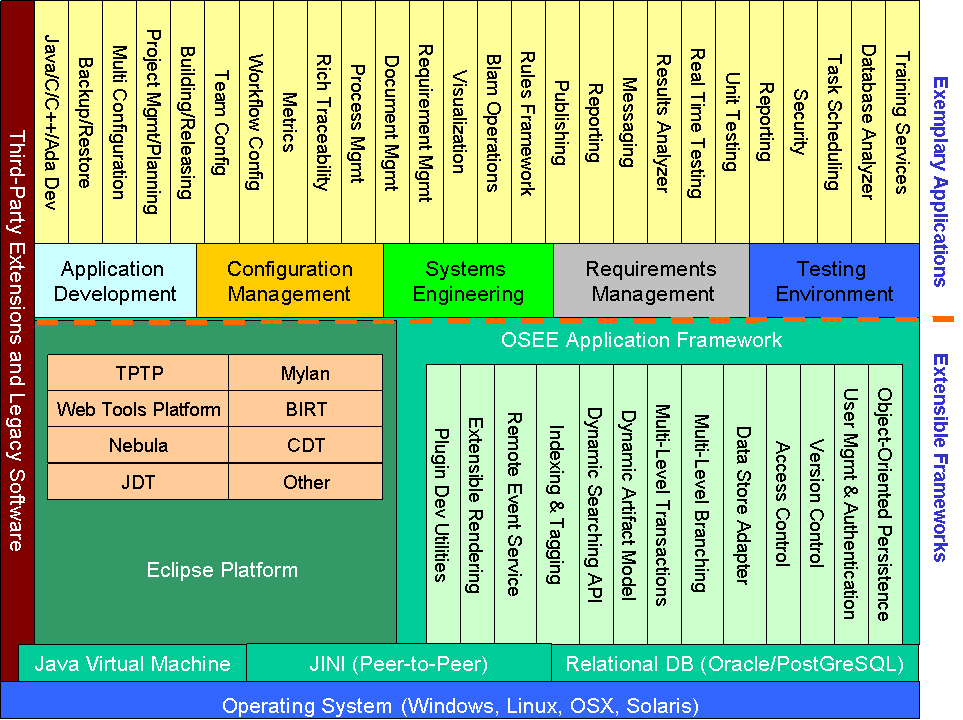 The Application Framework provides all the necessary services to allow the applications to persist and share data in a common, version controlled object database. Just as Eclipse provides the ability to add a plugin to the existing Eclipse environment, so OSEE allows other applications to add plugins and share the common data store.
The Application Framework provides all the necessary services to allow the applications to persist and share data in a common, version controlled object database. Just as Eclipse provides the ability to add a plugin to the existing Eclipse environment, so OSEE allows other applications to add plugins and share the common data store.
And just like Eclipse RCP allows an application to be built and deployed using the Eclipse framework but not include all the standard applications like JDT, OSEE allows an application to be built and deployed using the OSEE Application Framework without including such applications as OSEE Define and OSEE ATS.
Client/Server Architecture
In order to attain a greater degree of scalability, the Open System Engineering Environment (OSEE) has been slowly migrating into a distributed architecture where clients interact with an application server, which is in charge of managing access to an OSEE data store.
Additionally, in an effort to provide load balancing, failure recovery, and code compatibility, clients consult an arbitration server before connecting to an application server. The arbitration server's responsibility is to keep track of all the application servers interacting with a common data store and direct clients to a healthy application server compatible with the client's OSEE code version. In this arrangement, arbitration servers act as the initial access points into the OSEE server cloud where a collection of application servers manage client requests to access and operate on a common OSEE data store. Figure 1 shows an example of the OSEE Client/Server network.
In Figure 1, three application servers interact with a single OSEE data store. The data store is comprised of a relational database and a remote file system used to store binary data. It is not necessary for the database and the binary data to exist on the same machine; the only requirement is that the application servers have access to both resources. Upon start-up, each application server registers himself on the data store's server lookup table by entering its host address, port, supported code versions, and its unique id. When the arbitration server receives a request to find an application server to support a client connection, the arbitration server reads the data store's server lookup table and selects the best match for the client. The client requests this information from the arbitration server upon start-up or whenever it can't communicate with an application server. It is important to note that the arbitration server does not have to be a different server than an application server. All application servers are able to act as an arbitration server. An application server is referred to as an arbitration server when clients interact with it in this context. Figure 2 depicts the sequence of events involved in the arbitration process.
Once a client receives an application server's address and port information, the client must authenticate with the application server before it can gain access to the OSEE data store. During the authentication process, a client submits to the application server the current user's credential information and the authentication protocol id to use during the process. The application server verifies the user via the selected protocol and grants access to the data store by creating a session for the user. From this point forward, the application server will be responsible for managing access to the data store by identifying the user via the session id. Whenever a client wants to interact with the application server, it will need to submit its session id in order to gain access to the OSEE data store. Figure 3 shows the sequence of events involved in the authentication process.
Data Model
The OSEE framework is built around a user configurable and extensible data model consisting of attributes, artifacts, and relations. An attribute is a key-value pair representing a single data element such as a description, a date, a number, or a file. These basic data elements are grouped into artifacts. Artifacts can be configured to have any number of attributes. By default, an artifact will always have an attribute of type name. In addition, artifacts can be related to one another via relations. By default, an artifact will always have a default hierarchy relation type. This allows artifacts to be connected together in a tree. In the example below, two instances of the basic artifact type are shown. Artifact 1 has an attribute of type name set to string data "X". Artifact 2 has an attribute of type name set to string data "Y". These two artifact instances are related via the default hierarchy relation type. Artifact 1 is Artifact 2's parent artifact.
Now that we have a basic understanding of the model, lets take a closer look at attributes and how they are defined.
An attribute is defined through its attribute type. The attribute type is a blue print for constructing attribute instances. It defines the type of data the will be held by the attribute, the data source or who provides it, how many instances can be created, default value to use during creation, whether the attribute can be tagged for word searches, and if the attribute holds file data, its file extension.
By default, data contained in the attribute can be represented through OSEE's basic data types:
- String Attribute
- Boolean Attribute
- Integer Attribute
- Floating Point Attribute
- Date Attribute
- Enumerated Attribute
OSEE provides three attribute data providers: the default attribute data provider, URI attribute data provider, and the Clob attribute data provider.
- The default attribute data provider is used for data containing less than 4000 characters in length. Data is stored and retrieved from the OSEE relational database. Most attribute types will use this data provider to handle its data content.
- The URI attribute data provider is used for large data. The provider communicates to the OSEE application server to store and retrieve data.
- The Clob attribute data provider is a hybrid provider using both the OSEE relational database and the application server to retrieve and store data. When the data contained by the attribute has less than 4000 characters, the provider uses the relational database. If the data exceeds the 4000 character limit, then the application server is used.
Configuration Properties
OSEE can be configured by setting certain Java system properties when launching Eclipse and by setting various attribute values on the Global Preferences artifact in the datastore. Java system properties are key/value pairs and can be passed as launch arguments in the form of -D<key>=<value> (i.e. -Dosee.authentication.protocol=trustAll). These -D options can be specified directly in the command to launch Eclipse or in the corresponding .ini file for the eclipse executable used. Server-side OSGI properties are specified in an JSON file referenced by the system property cm.config.uri.
Server OSGi properties
See the file org.eclipse.osee.support.config/launchConfig/osee.postgresql.json for an example.
JdbcComponentFactory receives its OSGi properties from the JSON file referenced by the system property cm.config.uri. JdbcConnectionFactoryManager.getConnection() uses the JDK's DriverManager.getConnection() which in turn uses the Java Standard Edition Service Provider mechanism to load the JDBC driver referenced in the JSON file. The JDBC driver must include the file META-INF/services/java.sql.Driver which contains the name of the JDBC driver implementation of java.sql.Driver.
Datastore Preferences (via Global Preferences artifact)
Do a Quick Search on the Common branch for "Global Preferences" and open the resulting artifact in the artifact editor. The available attribute types for this artifact define what can be configured. Each attribute is self-documenting, because the attribute tip text documents how to use each one.
Common Java System Properties
| System Property Name | Values | Default | Description |
|---|---|---|---|
| osee.connection.info.uri | [FILE SYSTEM PATH]
|
File system path or uri containing custom database connection information. | |
| osee.db.connection.id | <db identifier>
|
Default from db.connection file | Specifies which database OSEE should connect to. This id references connection information specified in the ...db.connection.xml file. Refer to the Database Connection Information section for more information. |
| osee.jini.forced.reggie.search | true, false
|
false
|
If true, adds the lookupList to the global lookup list such that a refresh will try to locate the service again |
| osee.jini.lookup.groups | user defined group name | the Jini Group that all OSEE provided Jini services will register with | |
| osee.log.default | FINE, INFO, WARNING, SEVERE
|
WARNING
|
the default logging level for all loggers |
| osee.port.scanner.start.port | 1 - 65535
|
18000
|
the first port number to test for availability when a new port is needed |
Application Server Java System Properties
| System Property Name | Values | Default | Description |
|---|---|---|---|
| org.osgi.service.http.port | 1 - 65535
|
-1
|
Port the client will use to communicate with the OSEE Application Server |
| osee.application.server.data | [FILE SYSTEM PATH]
|
User Home | A directory on the file system to be used by the application server to store and serve artifact binary data. |
| osee.db.embedded.server | [<address>:<port>]
|
When specified, this system property sets the URL used to launch an embedded database server. | |
| osee.version | [<"version 1">;<"version 2">]
|
When specified, this system property sets the application server's supported client versions. NOTE: version string can use regular expressions | |
| osee.check.tag.queue.on.startup | true, false
|
false | When specified, this system property allows the application server to check the tag queue and begin tagging and pending tag jobs. |
Client Java System Properties
| System Property Name | Values | Default | Description |
|---|---|---|---|
| osee.application.server | <address>:<port>
|
When specified, this system property sets the URL used to reference the application server and arbitration is bypassed. | |
| osee.arbitration.server | <address>:<port>
|
The arbitration server address and port to use. This system property must be specified for the system to gain access to OSEE data. If the application server property is set then that address takes precedence and arbitration is bypassed. | |
| osee.authentication.protocol | protocol name | protocol to be used by the client to authenticate with the server | |
| osee.choice.on.db.init | choice name | the predefined database initialization choice | |
| osee.file.specified.schema.names.on.db.init | true, false
|
false
|
Specifies whether OSEE database initialization should use the schema names specified in the schema.xml files instead of using the connection schema. Using the connection specified schema is the default behavior. |
| osee.import.from.connection.id.on.db.init | [FILE SYSTEM PATH]
|
Specifies where table data should be imported from during OSEE database initialization. The default is to use the database connection id specified in the schema.xml files. | |
| osee.import.on.db.init | true, false
|
false
|
Specifies whether OSEE database initialization should import database data as part of its tasks. |
| osee.local.application.server | true, false
|
false
|
When set to true launches an application server upon start up. Uses org.osgi.service.http.port arg to determine port to use. |
| osee.local.http.worker.port | <port>
|
Port Scan starting from 18000
|
Port to use for local worker server. |
| osee.prompt.on.db.init | true, false
|
true
|
Specifies whether to interactively prompt the user during database initialization for init choice |
| osee.record.activity | true, false
|
true
|
Specifies whether user activity should be logged |
| osee.ote.benchmark | true, false
|
||
| osee.ote.cmd.console | true, false
|
Specifies whether to enable the OTE command console | |
| osee.ote.server.title | free text name | name given to the OTE server which is displayed in the test manager | |
| osee.ote.timing.log.path | |||
| osee.ats.ignore.config.upgrades | true, false
|
Setting Up Clients and Multiple Servers to work together
As described in the Architecture Section [1], the Clients can be configured to choose a particular server or group of servers. By specifying a server version, the arbitration server will pick only the application servers that are configured to work with the client. For instance, the configuration would make it possible to choose only servers in the same location as the clients.
Steps:
1. Configure each application server on the local server machine(s) to support the local clients.
a) Set the osee.version system property to a string that will provide a common property to use with the OSEE Client.
Example: In the VM Arguments for the server startup, add:
–Dosee.version=”localSiteName”
b) Set the osee.application.server.data to a location on the server for the local copy of the application data
Example: -Dosee.application.server.data=”path/to/local/data”
Note: this local path could be rsync’d to another site to improve local data performance
c) Set the http port to the port number for the client to access the server on
Example: -Dorg.osgi.service.http.port=8092
2. Configure the OSEE Client to connect to the one of the servers as an arbitration server
a) Set the osee.arbitration.server system property to the URL for one of the application servers configured in step 1.
Example: -Dosee.arbitrations.server=http://your.server.com:8092
b) Set the osee.version system property to match the application server(s)
Example: –Dosee.version=”localSiteName”
Developer Workspace Configuration
Import Java Code Auto Formatting Preferences
- Start OSEE
- File-->Import...
- Select General/Preferences
- Click Next >
- Click Browse and navigate to (and select) the file [workspace_root]\org.eclipse.osee\plugins\org.eclipse.osee.support.config\osee_team_preferences.epf
- Click Open
- Check Import all
- Click Finish
Configure New Code Template Preferences
- Window-->Preferences
- Java/Code Style/Code Templates
- Code/New Java Files
- Click Edit...
- Paste the following (or some variant). Be careful not to modify the template variables, i.e.: "${package_declaration}":
/*******************************************************************************
* Copyright (c) 2012 Boeing.
* All rights reserved. This program and the accompanying materials
* are made available under the terms of the Eclipse Public License v1.0
* which accompanies this distribution, and is available at
* http://www.eclipse.org/legal/epl-v10.html
*
* Contributors:
* Boeing - initial API and implementation
*******************************************************************************/
${package_declaration}
/**
* @author Joe P. Schmoe
*/
${typecomment}
${type_declaration}
- Code/Catch block body
- Click Edit...
- Paste the following (or some variant):
OseeLog.log(Activator.class, Level.SEVERE, ${exception_var});
Custom Data Model
The data model in OSEE is extensible and runtime user configurable without modification to code or the database schema. Users can define new artifact, attribute, and relation types and their constraints such as multiplicity and applicability. Type inheritance allows similar types to be defined and modified without tedious redundancy because the types inherit what is common from their super type.
The OSEE data model is defined using a XText grammar designed by the OSEE Team. This allows for editing of the types (object model) configuration much the way you would edit source code. This includes command completion and error notation when an incorrect syntax or keyword is used.
Example of the OSEE Types Editor
Command Completion Example
Error Handling Example
The OSEE types definitions are stored in artifacts and cached during startup. They are edited in OSEE like any other artifact. Simply select the artifact > right-click > open with > OSEE DSL Editor. Convention is to root them off the Common Branch default hierarchy.
Artifact Definitions
All artifact types extend the type "Artifact". The snippet below of the artifact type definition shows some types required by all OSEE configurations.
artifactType "Artifact" { <-- Main Artifact type
id 1 <-- Unique long artifact id
attribute "Name" <-- List of Attributes that are valid for this Artifact Type
attribute "Annotation"
attribute "Content URL"
attribute "Static Id"
attribute "Relation Order"
}
artifactType "User" extends "Artifact" { <-- User artifact extending Artifact
id 5
attribute "Active" <-- Adding more attributes to those inherited from Artifact
attribute "Phone"
attribute "Email"
attribute "Street Address"
attribute "Dictionary"
...
}
Attribute Definitions
Attribute types define characteristics (fields) of an artifact. They are strongly typed which supports data validation and editors and applications can know how to handle the values returned.
Here's an example of the "Name" attribute that exists on every Artifact.
attributeType "Name" extends StringAttribute { <-- extends one of the base Attribute Types
id 1152921504606847088 <-- unique long id of attribute type
dataProvider DefaultAttributeDataProvider <-- different dataProviders exist to store data differently
min 1 <-- minimum number of Attributes per artifact. can be 0..n
max 1 <-- maximum number of Attributes allowed. can be 1..n
taggerId DefaultAttributeTaggerProvider <-- defines the tagger is used to split the value for searching
description "Descriptive Name" <-- description of what this Attribute stores
defaultValue "unnamed" <-- default value to be used when min==1
mediaType "text/plain" <-- media types for this Attribute
}
oseeEnumType "enum.req.subsystem" { <-- Valid Enumerated values for the Subsystem attribute
id 3458764513820541310
entry "Robot_API"
entry "Robot_Survivability_Equipment"
entry "Robot_Systems_Management"
entry "Chassis"
...
}
attributeType "Subsystem" extends EnumeratedAttribute { <-- Enumerated Attribute definition
id 1152921504606847112
dataProvider DefaultAttributeDataProvider
min 1
max 1
taggerId DefaultAttributeTaggerProvider
enumType "enum.req.subsystem" <-- Enumeration definition from above
defaultValue "Unspecified"
mediaType "text/plain"
}
Valid Attribute Base-Types are:
- org.eclipse.osee.framework.skynet.core.BooleanAttribute
- org.eclipse.osee.framework.skynet.core.CompressedContentAttribute
- org.eclipse.osee.framework.skynet.core.JavaObjectAttribute
- org.eclipse.osee.framework.skynet.core.DateAttribute
- org.eclipse.osee.framework.skynet.core.FloatingPointAttribute
- org.eclipse.osee.framework.skynet.core.IntegerAttribute
- org.eclipse.osee.framework.skynet.core.StringAttribute
- org.eclipse.osee.framework.skynet.core.EnumeratedAttribute
- org.eclipse.osee.framework.skynet.core.WordTemplateAttribute
- org.eclipse.osee.framework.skynet.core.WordWholeDocumentAttribute
Relation Definitions
Relations provide bi-directional links between artifacts on a branch. Like Artifact and Attribute types, Relation types are strongly typed. You can identify which artifact types are allowed to be on each side of the relation. You can also specify the multiplicity.
relationType "Code-Requirement" { <-- Relation type name
id 2305843009213694296 <-- Unique long id
sideAName "code" <-- Name of the Artifacts on side A
sideAArtifactType "Code Unit" <-- Valid Artifact Type for side A
sideBName "requirement" <-- Name of the Artifacts on side B
sideBArtifactType "Requirement" <-- Valid Artifact Type for side B
defaultOrderType Unordered <-- Default Order Type
multiplicity MANY_TO_MANY <-- Multiplicity (any number of code can relate to any number of req)
}
relationType "Component-Requirement" {
id 2305843009213694297
sideAName "component"
sideAArtifactType "Component"
sideBName "requirement"
sideBArtifactType "Requirement"
defaultOrderType Unordered
multiplicity ONE_TO_MANY <-- Multiplicity (one component can relate to multiple requirements)
}
As described above, you can use command completion to see the valid values. An example is "multiplicity".
Making Types Changes in Production
- Search for OSEE Type Definition artifact types or find the types artifact on the Default Hierarchy of the Common Branch
- Select > Right-Click > Open With > DSL Editor
- Edit the types
- Remove all errors
- Save the editor
- Refresh the server types caches, do one of the following
- You should be prompted to update caches upon save. Select Yes for a single-server deployment.
- POST to server urls <SERVER_ADDRESS>/orcs/types/invalidate-caches
- curl -X POST <SERVER_ADDRESS>/orcs/types/invalidate-caches
- A server restart will also reload the new types, but is not required
- If the code needs a new version of the types sheets (eg: Type sheet grammar has changed), See Types Versioning section below.
Types and Access Control Versioning
As of the 24.0 line, the OSEE Types and Access Control Artifacts are "Versioned". This allows the "Production" version of the code to use one version of the types while another release line is being developed or prepared for release.
OSEE Types Instructions
Prior to 0.24.0, types were loaded based on the Artifact Type. After this, types are loaded by using the OrcsTypesData.OSEE_TYPE_VERSION to index into the tuple table and grab the gamma_ids of the types attributes to load. Thus this code variable needs to match up with the tuple entries for the new version of the types sheet(s).
To create a new types version
- Copy the existing types artifact and paste into OSEE Types folder. Types artifacts should be named for the last release they were used for (eg "Osee Type Config - 0.25.0") to reduce confusion.
- Make appropriate grammar and types changes in the new types sheets
- Update the code version number in org.eclipse.osee.framework.core.data.OrcsTypesData.OSEE_TYPE_VERSION to next number
- Update the tuple table to point to new OSEE Types Sheets gamma ids using OSEE_TYPE_VERSION number from last step at the web page <SERVER_ADDRESS>/orcs/types/config/ui/main.html
- NOTE: This MUST be done for each instance of OSEE database even if types didn't update
- While both production and developmental types sheets are in play, type changes MUST be made in both types sheets or one version will not see the types changes and produce errors.
- Types artifacts should be moved to a Retired OSEE Types folder when no longer used by any production releases. This helps reduce confusion for admins.
Access Control Instructions
- Copy the "ATS CM Access Control" artifact on common and paste with new name
- Replace the version at end of name
- Update AtsArtifactToken.AtsCmAccessControl token with new ids
- Make whatever access changes using DSL Editor on production to the newly created artifact
OSEE Branches
Workspace Setup
Downloading and Configuring Eclipse
Downloading and Configuring Eclipse
Working with GIT
Process for completing changes
- Before starting a change, for each repo: git pull --rebase
- Run the atside test suite that coincides with changes
- If fails, run again
- If fails twice, stop the server then delete db files
- Also remove {osee_client}\demo
- git status
- In red, changes listed
- Verify they are what is expected
- gitk
- review changes
- git commit --m "<feature/refinement/..>: Description" -a -s
- e.g. git commit --m "feature: Web Config" -a -s
- -s only if you are not a committer
- -a means all (if you don't want all you omit the -a and replace with filename(s))
- e.g. git commit --m "feature: Web Config" -a -s
- If committed - and need to reset
- git lg -10
- locate commit that you want to revert. Highlight/Write down version prior (and current version if you want to re-use)
- e.g. $ git lg -10
- git reset <paste version>
- e.g. git reset 35bce46
- git lg -10
- git status
- should show previously committed changes in red
- Do git co of files you didn't intend to change (or remove)
- git commit -c <previous id> -a
- Commits changes again, using previous id (don't use -m)
When making multiple commits that need to look one
- git lg -10
- be sure the latest commits are the ones you want to "squash"
- git rebase -i
- Editor will pop up
- Replace "pick" with "squash" for commits that need to be rolled up. Leave "pick" on the first commit. Click Save and Exit.
- Another Editor will pop up
- Keep only the first commit message
- git lg -10
- One commit should be left, representing all changes and it should be the latest
Before pushing to review
- In org.eclipse.osee repo do
- git pull --rebase
- Run AtsIde Suites to be sure they pass WITH YOUR changes
Push to review
- git push review_dev
- Take link that results and send to two developers for review.
If there are comments/changes needed based on reviews
- Open previously used workspace, make changes, pass the test and push it for review
Merge changes
- Confirm changes have been reviewed by at least 2 people
- Confirm build has passed (Gerrit will give a +1)
- Ask committer to merge changes
- Create a clean repo/workspace
- In all repos: git pull --rebase
- Confirm it compiles
After committer has merged changes and it is verified that they work
- Move task to Review in any external tracking tools
- Move task to Complete in OSEE
When you want to reset repo to head (ok with losing changes)
- cherry pick101
- ONCE a commit has been pushed; and further changes are needed based on review???
- on git web, find the change (e.g. https://git.eclipse.org/r/#/c/148379/)
- Click on the Download drop-down to the right and copy the link for CherryPick
- then do
- . <paste command>
- e.g. git fetch https://git.eclipse.org/r/osee/org.eclipse.osee refs/changes/79/148379/1 && git cherry-pick FETCH_HEAD
- . <paste command>
- IMPORTANT: if making changes to osee types (ie xxx).... must commit to database before pushing java to repo!
purging a branch- USE WITH CAUTION
- powershell
- telnet {server_url} {port}
- oseehelp
- DO NOT ENTER THE WORD: "exit" OR "quit"
How to push only one commit of a stack of commits
- Order the commits using rebase -i, making the commit you want the oldest
git notes
- git pull --rebase
- git status
- git add <path>
- git commit
- git commit --append <path>
- git push review_dev
- git clean -fdx (before doing this be sure you have NO uncommitted changes)
- send path to two other developers to review changes
git reset --hard origin/dev **only do when you have NO uncommitted changes
Testing
JUnit Method Rules:
| Rule class | Description | Example |
|---|---|---|
| OseeHousekeepingRule | Checks if the Artifact Cache is clean |
public class MyTest {
@Rule
public MethodRule oseeHousekeepingRule = new OseeHousekeepingRule();
|
Location of OSEE Bundles
Migrating Branches to Another OSEE Database (including from previous OSEE version)
- From the source application server's osgi console: export_branch myExportFolder
- The results will be placed in <user home>\Exchange\myExportFolder
- Zip the resulting folder and save it for possible reuse
- Run database initialization on destination database
|
eclipsec -application org.eclipse.osee.framework.database.init.configClient -vmargs -Xmx512m -Dosee.log.default=INFO -Dosee.application.server=http://localhost:8089 -Dosee.authentication.protocol=trustAll -Dosee.prompt.on.db.init=false -Dosee.choice.on.db.init="Base - for importing branches" |
- Import any custom types into the destination database
- From the destination application server's osgi console: import_branch <user home>\Exchange\myExportFolder
- From the application server run
tag_all - Restart destination application server
- Start corresponding OSEE client
Fully Purge Branch and its backing data
For situational awareness
Review the branch transactions
SELECT * FROM osee_tx_details WHERE branch_id = ? AND tx_type = 0;
Review uniquely created versions on this branch
SELECT UNIQUE(gamma_id) FROM osee_tx_details txd, osee_txs txs1 WHERE txd.branch_id = ? AND tx_type = 0 AND txd.branch_id = txs1.branch_id AND txd.transaction_id = txs1.transaction_id AND NOT EXISTS (SELECT 1 FROM osee_txs txs2 WHERE txs1.gamma_id = txs2.gamma_id AND txs2.branch_id <> 6277884563228332544) ORDER BY gamma_id;
Record URI of binary attributes to delete
SELECT URI FROM osee_tx_details txd, osee_txs txs1, osee_attribute att WHERE txd.branch_id = ? AND tx_type = 0 AND txd.branch_id = txs1.branch_id AND txd.transaction_id = txs1.transaction_id AND NOT EXISTS (SELECT 1 FROM osee_txs txs2 WHERE txs1.gamma_id = txs2.gamma_id AND txs2.branch_id <> 6277884563228332544) AND txs1.gamma_id = att.gamma_id AND URI IS NOT NULL;
Delete gammas from OSEE item tables
DELETE FROM osee_relation_link WHERE gamma_id IN (SELECT gamma_id FROM osee_tx_details txd, osee_txs txs1 WHERE txd.branch_id = ? AND tx_type = 0 AND txd.branch_id = txs1.branch_id AND txd.transaction_id = txs1.transaction_id AND NOT EXISTS (SELECT 1 FROM osee_txs txs2 WHERE txs1.gamma_id = txs2.gamma_id AND txs2.branch_id <> 6277884563228332544)); DELETE FROM osee_artifact WHERE gamma_id IN (SELECT gamma_id FROM osee_tx_details txd, osee_txs txs1 WHERE txd.branch_id = ? AND tx_type = 0 AND txd.branch_id = txs1.branch_id AND txd.transaction_id = txs1.transaction_id AND NOT EXISTS (SELECT 1 FROM osee_txs txs2 WHERE txs1.gamma_id = txs2.gamma_id AND txs2.branch_id <> 6277884563228332544)); DELETE FROM osee_attribute WHERE gamma_id IN (SELECT gamma_id FROM osee_tx_details txd, osee_txs txs1 WHERE txd.branch_id = ? AND tx_type = 0 AND txd.branch_id = txs1.branch_id AND txd.transaction_id = txs1.transaction_id AND NOT EXISTS (SELECT 1 FROM osee_txs txs2 WHERE txs1.gamma_id = txs2.gamma_id AND txs2.branch_id <> 6277884563228332544));
Final Purge
- Purge the branch using the administrative operation "Purge Branch" from the Branch Manager
- If applicable, purge associated ATS workflow
- Delete binary attributes from file system
Configuring ATS for Change Tracking
Configuring ATS for Change Tracking
Custom OSEE Operations using BLAM
the extension point org.eclipse.osee.framework.ui.skynet.BlamOperation can be used to contribute a custom OSEE operation that provides the developer a very quick way to define the graphical interface that supplies the operation with the user specified parameters. org.eclipse.osee.framework.ui.skynet.blam.operation.ChangeArtifactTypeBlam provides a simple example.
Event Handling
General Design Considerations
- Event Handlers should run VERY quickly
- A private implementation is more secure
- Separate classes == maintainable but potentially costly
- Ensure each listener is safeguarded from other listeners (wrap in event handling)
Requirements
- Need local client events and remote events to other clients
- Local event model should be abstracted from remote model so app code doesn't change
- Remote events should be versioned so event service can know how to handle
- Need to handle events where artifact or relation is not in client's cache, but event may still matter
- Client can't load every artifact to determine if it's desired
- Registration needs to be at base level guid,artTypeId,branchId so these can be filtered out without loading all artifact data.
- Need to provide lowest level registration (branch, artType and possibly even attrType) so event msgs reduced
- Need to support versions of remote events so remote event model can change without causing exceptions
- MUST have regression tests that are light-weight and easy to run so event service doesn't break
- Since Artifact, Relation, Attribute types are dynamic, can't create static message model/brokers
- Since artifact/relation/branch caches must be updated PRIOR to events propagate to GUI
- Need priority listeners for caches to update prior to UI updates
- Applications should be able to define their own higher level events while still listening to lower level events
Event Handling Revelations
- Reduce the necessity of events as much as possible - Restful
- Data injection to keep caches up-to-date a complex/impossible solution for enterprise, multi-client, multi-server operations
- All clients MUST be connected to event service if connected to database/app service
- Applications shouldn't have to know what events to handle, but instead presented all the events to handle
- Don't have separate purge, modified, change type events, but instead Artifact listener that has change types of purge, modified, deleted, change type, etc
- Since artifacts/relations are cached, application to application events are prone to errors if cache not updated yet
Event Handling Ideas / Goals
- How could we have a version for each artifact so clients could know if they are up-to-date or missed an update and reload-all. This would allow for self-healing.
- Reduce the items in the cache by improving our use of weak references. Anything not in the cache, doesn't have to get updated
- Move configurations that have to be loaded by all clients to the server. Branch and type caches already there. Users and ATS Config could go there.
- Is there a way to have events go straight to UIs (Editors, Views) to see if anyone cares that the cache is updated before updating the cache?
OSEE Event Handling - Current
- Design Issues
- Communication mechanism - Jini
- Clients are not connecting
- Clients not staying connected
- Event System
- Events are at the data level; applications are required to turn high level operations (eg: save, transition) into low level data events (30 attributes modified, 10 relations added, 5 deleted) which are sent across the wire to another client to re-assemble into a high level operation.
- Registration is for too high a level, each editor,view has to process through all events to find ones they care about
- Have to filter between loaded and unloaded artifacts and handle them differently so as not to accidentally load everything
- Have to register/handle separately for deleted versus purged
- Two levels of registration for artifacts/attributes/relations, by transaction and by dirty. By dirty is too much information, but necessary sometimes. By transaction is ok, but have to filter through all un-necessary stuff to find what want. Dangerous and costly.
- Access control is not handled in events
- Not extensible, so applications can't create/propagate their own events
- Communication mechanism - Jini
- Registration
- ArtifactPurgedEvent
- FrameworkTransactionEvent
- RelationModifiedEvent
- BranchEvent
OSEE Event Handling - New
- Registration - Need lower level registration of framework events
- By Artifact (branch, guid)
- By Object Type (artifact, attribute, relation) - include inheritance
- By Mod Type (added, modified, deleted, purged)
- By Transaction (persist to DB of group of changes)
- By Combinations (Artifact type and relation type or Artifact type and attribute type)
- ArtifactEventManager
- Sends BasicGuidArtifact for each mod type
- Modification Types: Purged, Added, Modified, Deleted, Change Type, Access Control
- Allow registration with filters
- ArtifactGuidFilter - only sends event if artifact is affected
- BranchGuidFilter - only send event if artifact on this branch is affected
- ArtifactTypeGuidFilter - only sends event if artifact of one of these types is affected
- BranchEventManager
- Modification Types: Added, Deleted, Purged, Access Control, Renamed
- Allow registration with same filters as Artifact
- Remote events are different and versioned classes so abstract from framework events
- Created via jaxb
Event Model
Remote Events
- Remote events classes are auto-generated via jaxb which keeps toXml, fromXml implementation hidden and thus requires less junit tests for base clasess.
- Each class is versioned by name (1, 2, 3). When RemoteBranchEvent1 changes, will create RemoteBranchEvent2 so there is no conflicts and implement backward compatibility that will
- Create RemoteBranchEvent2 events when RemoteBranchEvent1 are received - for old clients
- Create RemoteBranchEvent1 events when RemoteBranchEvent2 are received - for new clients
- Current classes:
- RemoteAccessControlArtifactsEvent1.java
- RemoteAttributeChange1.java
- RemoteBasicGuidArtifact1.java
- RemoteBasicModifiedGuidArtifact1.java
- RemoteBranchEvent1.java
- RemoteBranchRenameEvent1.java
- RemoteBroadcastEvent1.java
- RemoteChangeTypeArtifactsEvent1.java
- RemoteNetworkSender1.java
- RemotePurgedArtifactsEvent1.java
- RemoteTransactionDeletedEvent1.java
- RemoteTransactionEvent1.java
Framework Events / Listeners
- ArtifactEvent
- BranchEvent
- BroadcastEvent
- AccessControl?? - Potentially roll into ArtifactEvent
- TransactionDeleted?? - Potentially roll into ArtifactEvent
Use Cases
- Artifact Editor
- Current Design
- Registration = All Branches, Mod Types, Object Types
- Handling
- If not branch, throw away
- If unloaded, ignore
- If loaded refresh/update all
- If relation, refresh relation tree
- If attribute, refresh attribute tab
- New Design
- Registration = One guid and relations for that guid
- Handling
- If relation, refresh relation tree
- If attribute, refresh attribute tab
- Current Design
- Artifact Explorer
- Current Design
- Registration = All Branches, Mod Types, Object Types
- Handling
- If not branch, throw away
- If unloaded, ignore
- If loaded refresh/update all
- If relation, get parent and call tree.refresh()
- If attribute (name only), call tree.update(element)
- New Design
- Registration = One branch, One relation type, All Object Types
- Handling = About the same, but don't have to filter through un-necessary stuff
- Current Design
- SMA Editor - Edits single team workflow, but watches related tasks, reviews, user assignments, etc
- Current Design
- Registration = purged, relation modified, framework transaction, branch event. NOTE: Should register by branchId (Common), guids of workflows, artifact types (eg. don't care about general document artifact type changes on common)
- Handling
- If not Common branch or in transition, ignore all artifact/relation/attribute changes
- If is purged/deleted, close editor
- If is modified, deleted, relChanged, relDeleted, relAdded of main artifact, redraw pages
- If related review is any of above, redraw pages
- If relation modified, dirty editor
- If branch event and working branch added, deleted, purged, committed, redraw pages
- New Design
- Registration - One branch, 12 artifact types
- Handling = About the same, but don't have to filter through un-necessary stuff
- Current Design
References
Building OSEE using Tycho/Maven
Build Requirements
- Java Runtime Environment (JRE) 1.6 or higher
- Maven 3.0 or higher
Build Steps
- Download and install Maven. See http://maven.apache.org for installation details.
- Download the OSEE source code from Git Web Client (see clone section for more information] or https://github.com/eclipse/osee
- Note: Tycho/Maven build support available for source code versions 0.9.9_SR6 and higher.
- Download and unzip 3rd party dependency P2 archived site: http://code.google.com/p/osee-external/downloads/detail?name=org.eclipse.ip.p2_1.0.0.v201203200040-DEV.zip&can=2&q=
- Build commands:
- cd org.eclipse.osee/plugins/org.eclipse.osee.parent
- mvn clean verify -Declipse-ip-site="file:<PATH TO 3rd PARTY P2 SITE>"
- If you run into any problems (to display debug and stack trace info)
- mvn -e -X verify -Declipse-ip-site="file:<PATH TO 3rd PARTY P2 SITE>"
Assuming the following layout:
/UserData/org.eclipse.osee
/UserData/org.eclipse.ip.p2_1.0.0.v201203200040-DEV
machine@user /UserData/org.eclipse.osee/plugins/org.eclipse.osee.parent:
$mvn clean verify -Declipse-ip-site="file:../../../org.eclipse.ip.p2_1.0.0.v201203200040-DEV"
Interactive Build
☞ Depends on org.eclipse.osee.ip.p2
- To build all org.eclipse.osee artifacts
- cd org.eclipse.osee/plugins/org.eclipse.osee.support.maven
- Issue maven build command: mvn compile -Declipse-ip-site="file:../../../org.eclipse.ip.p2_1.0.0.v201203200040-DEV"
- Select build options when prompted
Build Module Hierarchy (from highest to lowest)
- org.eclipse.osee.parent
- org.eclipse.osee.ide.parent
- org.eclipse.osee.client.all.parent
- org.eclipse.osee.client.parent
- org.eclipse.osee.ote.parent
- org.eclipse.osee.runtime.parent
- org.eclipse.osee.x.parent
- org.eclipse.osee.x.server.parent
- org.eclipse.osee.orcs.parent
- org.eclipse.osee.x.core.parent
- org.eclipse.osee.ide.parent
Build Artifacts
| Path | Artifact | Description |
|---|---|---|
| plugins/org.eclipse.osee.client.all.p2/target/ | repository/ | OSEE IDE Client P2 Site |
| org.eclipse.osee.client.all.p2.zip | OSEE IDE Client P2 Archived Update Site | |
| plugins/org.eclipse.osee.client.all.product/target/products/ | build_label.txt | OSEE Build Information |
| org.eclipse.osee.ide.id-linux.gtk.x86.tar.gz | OSEE Client IDE All-In-One Linux x86 | |
| org.eclipse.osee.ide.id-linux.gtk.x86_64.tar.gz | OSEE Client IDE All-In-One Linux x86 64-bit | |
| org.eclipse.osee.ide.id-win32.win32.x86.zip | OSEE Client IDE All-In-One Win32 x86 | |
| org.eclipse.osee.ide.id-win32.win32.x86_64.zip | OSEE Client IDE All-In-One Win32 x86 64-bit | |
| plugins/org.eclipse.osee.x.server.p2/target | repository/ | OSEE Application Server P2 Site |
| server/ | OSEE Application Server | |
| org.eclipse.osee.x.server.p2.zip | OSEE Application Server Archived Update Site | |
| org.eclipse.osee.x.server.runtime.zip | OSEE Application Server Zipped Runtime |
OSEE System Requirements
- System with at least 1GB of RAM
- Relational database. H2 is included by default. If you wish to use something else such as PostgreSQL or Oracle, please see instructions for installing Supported Databases to complete this step.
How to Define Classes for Coverage Importing
The following steps walk a developer through defining the classes necessary to begin importing coverage data into the OSEE application. Please keep in mind that these are meant to be simplified examples and developers are encouraged to 'get creative' when adapting these examples to their own particular context.
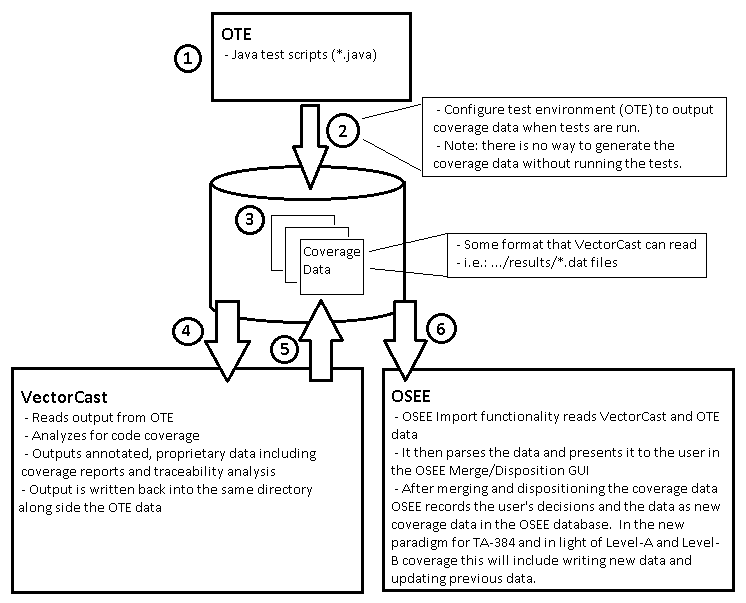
1. Write a class that extends AbstractCoverageBlam
public class MyCoverageImportBlam extends AbstractCoverageBlam {
public static String COVERAGE_IMPORT_DIR = "Coverage Import Directory";
public static String NAMESPACE = "Code Namespace";
@Override
public String getName() {
return "My Coverage Import";
}
@Override
public Collection<String> getCategories() {
return Arrays.asList("Blams");
}
@Override
public String getDescriptionUsage() {
return "Import coverage from coverage directory.";
}
@Override
public void runOperation(final VariableMap variableMap, IProgressMonitor monitor) throws Exception {
try {
final String coverageInputDir = variableMap.getString(COVERAGE_IMPORT_DIR);
if (!Strings.isValid(coverageInputDir)) {
throw new OseeArgumentException("Must enter valid filename.");
}
final String namespace = variableMap.getString(NAMESPACE);
if (!Strings.isValid(namespace)) {
throw new OseeArgumentException("Must enter valid namespace.");
}
File file = new File(coverageInputDir);
if (!file.exists()) {
throw new OseeArgumentException("Invalid filename.");
}
MyCoverageImporter myCoverageImporter = new MyCoverageImporter(coverageInputDir, namespace);
CoverageImport coverageImport = myCoverageImporter.run(monitor);
setCoverageImport(coverageImport);
} catch (Exception ex) {
OseeLog.log(Activator.class, OseeLevel.SEVERE_POPUP, ex);
}
}
@Override
public String getXWidgetsXml() {
StringBuffer buffer = new StringBuffer("<xWidgets>");
buffer.append("<XWidget xwidgetType=\"XDirectorySelectionDialog\" " + getDefaultDirectory() + " displayName=\"" + COVERAGE_IMPORT_DIR + "\" />");
buffer.append("<XWidget xwidgetType=\"XText\" displayName=\"" + NAMESPACE + "\" />");
buffer.append("</xWidgets>");
return buffer.toString();
}
private String getDefaultDirectory() {
if (CoverageUtil.isAdmin()) {
return " defaultValue=\"C:\\UserData\" ";
}
return "";
}
}
2. Define a class that implements ICoverageImporter
public class MyCoverageImporter implements ICoverageImporter {
private final String coverageInputDir;
private final String namespace;
private final CoverageImport coverageImport = new CoverageImport("My Coverage Import");
public MyCoverageImporter(String coverageInputDir, String namespace) {
this.coverageInputDir = coverageInputDir;
this.namespace = namespace;
}
@Override
public String getName() {
return "My Coverage Importer";
}
@Override
public CoverageImport run(IProgressMonitor progressMonitor) throws OseeCoreException {
/*
* Use any member variables to populate coverageImport
*/
return coverageImport;
}
}
3. Add extension point declaration to package's plugin.xml
<?xml version="1.0" encoding="UTF-8"?>
<?eclipse version="3.4"?>
<plugin>
<extension
point="org.eclipse.osee.framework.ui.skynet.BlamOperation">
<Operation
className="com.my.coverage.MyCoverageImportBlam">
</Operation>
</extension>
</plugin>
Using and Updating Swagger
Swagger is an in-depth web/UI-based API documentation and interactive tool, which is now incorporated into the OSEE framework. Below are instructions on using and updating the tool.
Browsing/Utilizing The Swagger Web Application
The Swagger web application is located here: http://<host>/swagger/index.html, where <host> is the top-level domain of your organization, or http://localhost:<port> when running a local server on a development machine.
Multiple Definitions
The default "definition" API endpoints will be shown and are based on the Select a definition dropdown field selection in the upper-right hand corner of the page. APIs are grouped by definition, which are pre-generated files we produce and continually update. The Swagger application utilizes these custom definition files, currently in JSON format, to display a list of API endpoints and their features defined in its respective definition file.
Servers
The Servers dropdown field contains only one selection for now, but can be used to specify alternate, specific servers in the future.
Searchable Tagging
Just below the Servers field, you'll find the Filter by tag text field. Swagger tags are custom searchable keywords we provide for groups of endpoints. They allow quick filtering of endpoints the user may be interested in, as the complete list of endpoints per definition may be very lengthy.
Generating/Updating The Definition Files
The Swagger definition files are generated by package-specific Java applications located under each targeted package. They can be Run or Debugged individually or all in tandem by running or debugging the parent SwaggerGenerator application located under org.eclipse.osee.ats.ide.integration.test.util package.
- Right-click on the SwaggerGenerator.java file and select Run As or Debug As -> Java Application
- The SwaggerGenerator.java class subsequently calls each package-specific Generator application in under its respective package. Refer to the SwaggerGenerator class to determine which classes/applications are called.
- Observe the Console for any errors during generation.
- The newly generated or updated files will be located under org.eclipse.osee.web.ui/src/swagger/definitions in this format: <reformatted package name>.json
Adding New Endpoints To An Existing Swagger Annotated Class
An existing Swagger-annotated class has the @Swagger annotation placed at the class level. When adding a new endpoint to an existing and properly set up Swagger-annotated class, the new endpoint will be picked up automatically as long as the endpoint is annotated with a @Path annotation, with these points in mind:
- The new endpoint may or may not have any searchable Swagger tagging applied to it automatically. This will depend on whether or not its associated package-level Generator class has generic tagging implemented (see Generic versus Explicit Tagging below).
- The new endpoint will not have any documentation associated with it on the Swagger web application until the proper Swagger annotations are added to the endpoint.
- The new endpoint will otherwise have full functionality, depending on security settings, minus the useful documentation.
Adding A New Swagger Annotated Class To A Swagger-Aware Package
A "Swagger-aware package" contains its own custom Swagger Generator class/application, which scans for all Swagger-annotated classes under that particular package. A Swagger-annotated class contains the @Swagger annotation at the class level. When adding a new Swagger-annotated class to a Swagger-aware package, add the @Swagger annotation at the class level for this new class. For any containing endpoints to be picked up by the Swagger web application, they must have a @Path annotation, at minimum.
Referencing An Existing Package To Be Included In Swagger Scanning
In order for all Swagger-annotated classes under a particular package to be scanned, and subsequently added to the Swagger web application, a Generator Class needs to be implemented within that package. See the following code example below. This particular class has generic tagging implemented, which provides out-of-the-box searchable tagging support for Swagger-annotated classes with no Swagger endpoint documentation tags implemented yet.
- Ensure the definitionFile variable replaces periods in the package name with underscores, and only uses one period before the json file extension name.
- The definitionPath variable should not change.
- infoTitle, infoDescription, serverUrl, and serverDescription should all change based on the new definition.
- Endpoints in multiple packages need to have each respective package listed, as shown. Some bundles will have all endpoints in a single package, however.
- IMPORTANT: Implementing both generic tagging and Swagger documentation tagging under a particular package should be avoided, as the Swagger application will generate both tagging versions, which will have different naming conventions and will be confusing to the user. It needs to be one or the other; not a combination of both. For example, if the generator class has generic tagging implemented, then no endpoints should have any Swagger documentation annotation tags. It's best practice to provide all Swagger documentation tags for each endpoint under the particular package, and then remove the generic tagging implementation in the generator class in a single commit.
public class DefineApiSwaggerGenerator {
private static final String definitionPath = "../org.eclipse.osee.web.ui/src/swagger/definitions/";
// Only one period in the definition file name is supported
private static final String definitionFile = "org_eclipse_osee_define_api.json";
private static final String infoTitle = "Define API Endpoint Definitions";
private static final String infoDescription = "Allows interactive support for Define API endpoints.";
private static final String serverUrl = "/define";
private static final String serverDescription = "Define";
public static void main(String[] args) {
Set<Class<?>> allClasses = Lib.getAllClassesUnderPackage("org.eclipse.osee.define.api");
allClasses.addAll(Lib.getAllClassesUnderPackage("org.eclipse.osee.define.api.publishing"));
allClasses.addAll(Lib.getAllClassesUnderPackage("org.eclipse.osee.define.api.publishing.datarights"));
allClasses.addAll(Lib.getAllClassesUnderPackage("org.eclipse.osee.define.api.publishing.templatemanager"));
allClasses.addAll(Lib.getAllClassesUnderPackage("org.eclipse.osee.define.api.synchronization"));
allClasses.addAll(Lib.getAllClassesUnderPackage("org.eclipse.osee.define.api.toggles"));
Set<Class<?>> swaggerClasses = new HashSet<Class<?>>();
for (Class<?> clazz : allClasses) {
if (clazz.isAnnotationPresent(Swagger.class)) {
swaggerClasses.add(clazz);
}
}
System.out.println("Creating Swagger " + definitionFile + " definitions file. Please wait...");
// Read in all applicable classes, creating initial Swagger openAPI definition object
OpenAPI openAPI = new Reader(new OpenAPI()).read(swaggerClasses);
Info info = new Info();
info.setTitle(infoTitle);
info.setDescription(infoDescription);
openAPI.setInfo(info);
Server server = new Server();
server.setUrl(serverUrl);
server.setDescription(serverDescription);
openAPI.addServersItem(server);
// Add searchable tagging support to groups of endpoints
Map<String, PathItem> taggedPaths =
openAPI.getPaths().entrySet().stream().map(entry -> new AbstractMap.SimpleEntry<>(entry.getKey(),
addTagsToPathItem(entry.getKey(), entry.getValue()))).collect(
Collectors.toMap(Map.Entry::getKey, Map.Entry::getValue));
Paths paths = new Paths();
paths.putAll(taggedPaths);
openAPI.setPaths(paths);
try (FileWriter fr = new FileWriter(definitionPath + definitionFile)) {
fr.write(Json.mapper().writeValueAsString(openAPI));
} catch (JsonProcessingException e) {
e.printStackTrace();
} catch (IOException e) {
e.printStackTrace();
}
System.out.println("Swagger " + definitionFile + " definitions file created.");
System.out.println("");
}
private static PathItem addTagsToPathItem(String path, PathItem pathItem) {
String pathElements[] = path.split("/");
if (pathItem.getGet() != null) {
pathItem.getGet().addTagsItem(pathElements[1]);
}
if (pathItem.getDelete() != null) {
pathItem.getDelete().addTagsItem(pathElements[1]);
}
if (pathItem.getHead() != null) {
pathItem.getHead().addTagsItem(pathElements[1]);
}
if (pathItem.getPatch() != null) {
pathItem.getPatch().addTagsItem(pathElements[1]);
}
if (pathItem.getPost() != null) {
pathItem.getPost().addTagsItem(pathElements[1]);
}
if (pathItem.getPut() != null) {
pathItem.getPut().addTagsItem(pathElements[1]);
}
if (pathItem.getTrace() != null) {
pathItem.getTrace().addTagsItem(pathElements[1]);
}
if (pathItem.getOptions() != null) {
pathItem.getOptions().addTagsItem(pathElements[1]);
}
return pathItem;
}
}
Here is an example of a class with no generic tagging implemented. All of the enpoint classes under this particular package, for which the generator class is handling have Swagger documentation tagging implemented for each endpoint instead. This customized documentation tagging takes better advantage of Swagger's capabilities, however takes more work documenting each endpoint. For classes under packages that have not been documented yet, generic tagging may be used in the meantime.
public class DispoSwaggerGenerator {
private static final String definitionPath = "../org.eclipse.osee.web.ui/src/swagger/definitions/";
// Only one period in the definition file name is supported
private static final String definitionFile = "org_eclipse_osee_disposition_rest.json";
private static final String infoTitle = "Dispo API Endpoint Definitions";
private static final String infoDescription = "Allows interactive support for Dispo API endpoints.";
private static final String serverUrl = "/dispo";
private static final String serverDescription = "Dispo";
public static void main(String[] args) {
Set<Class<?>> allClasses = Lib.getAllClassesUnderPackage("org.eclipse.osee.disposition.rest.resources");
Set<Class<?>> swaggerClasses = new HashSet<Class<?>>();
for (Class<?> clazz : allClasses) {
if (clazz.isAnnotationPresent(Swagger.class)) {
swaggerClasses.add(clazz);
}
}
System.out.println("Creating Swagger " + definitionFile + " definitions file. Please wait...");
// Read in all applicable classes, creating initial Swagger openAPI definition object
OpenAPI openAPI = new Reader(new OpenAPI()).read(swaggerClasses);
Info info = new Info();
info.setTitle(infoTitle);
info.setDescription(infoDescription);
openAPI.setInfo(info);
Server server = new Server();
server.setUrl(serverUrl);
server.setDescription(serverDescription);
openAPI.addServersItem(server);
System.out.println("Swagger " + definitionFile + " definitions file created.");
System.out.println("");
}
}
1. Add the new class to the parent SwaggerGenerator.java class:
public class SwaggerGenerator {
public static void main(String[] args) {
DefineApiSwaggerGenerator.main(args);
MimSwaggerGenerator.main(args);
OrcsSwaggerGenerator.main(args);
AtsApiSwaggerGenerator.main(args);
DispoSwaggerGenerator.main(args);
// Add new Swagger Generator class here
}
}
2. Add the new definition file reference URL to the swagger-initializer.js file under org.eclipse.osee.web.ui/src/swagger/node_modules/swagger-ui-dist/ Make sure it is placed in alphabetical order based on its "name" attribute in the "urls" array:
window.onload = function() {
//<editor-fold desc="Changeable Configuration Block">
// the following lines will be replaced by docker/configurator, when it runs in a docker-container
window.ui = SwaggerUIBundle({
// Alphabetical:
urls: [
{
url: "/swagger/definitions/org_eclipse_osee_ats_api.json", name: "ATS API Endpoints"
},
{
url: "/swagger/definitions/org_eclipse_osee_define_api.json", name: "Define API Endpoints"
},
{
url: "/swagger/definitions/org_eclipse_osee_disposition_rest.json", name: "Dispo API Endpoints"
},
{
url: "/swagger/definitions/org_eclipse_osee_mim.json", name: "MIM API Endpoints"
},
{
url: "/swagger/definitions/org_eclipse_osee_orcs_rest.json", name: "Orcs Endpoints"
}
],
dom_id: '#swagger-ui',
filter: true,
configUrl: '/swagger/swagger-config.json',
deepLinking: true,
presets: [
SwaggerUIBundle.presets.apis,
SwaggerUIStandalonePreset
],
plugins: [
SwaggerUIBundle.plugins.DownloadUrl
],
layout: "StandaloneLayout",
supportedSubmitMethods: [
"get",
"head"
]
});
//</editor-fold>
};
3. For any classes to picked up by the Swagger web application for this new definition, the @Swagger annotation must be added to any relevant classes at the class level, and any relevant endpoint needs to be annotated with the @Path annotation, at minimum.
Generic Versus Explicit Tagging
As stated above, generic tagging may be utilized in the meantime until all endpoints under a particular Swagger-aware package are fully documented with Swagger documentation tagging. For a full description of supported Swagger annotation tagging, refer to the Swagger 2.X Annotations documentation here:
Below is an example of Swagger documentation annotation tagging on an enpoint. In this case, the Swagger-specific documentation tags are:
- @Operation (This particular tag includes a summary, which is shown as visible text on this endpoint's dropdown field within the Swagger web application.)
- @Tags (An array container for multiple @Tag annotations. For a single @Tag annotation, the @Tags array annotation is not needed.)
- @Tag (This is the searchable text for one or more endpoint "types," e.g. "branches". Two @Tag annotations on a single endpoint will appear in two locations. This number should be kept at a minimum; otherwise the page may end up with too many entries for the same endpoint.)
- @ApiResponses (An array container for multiple @ApiResponse annotations. For a single @ApiResponse annotation, the @ApiResponses array annotation is not needed.)
- @ApiResponse (In this case the response code and its description.)
- @Parameter (Inline annotation used to describe the formal parameter, e.g. @QueryParam)
@Path("{name}")
@POST
@RolesAllowed(DispoRoles.ROLES_ADMINISTRATOR)
@Consumes(MediaType.APPLICATION_FORM_URLENCODED)
@Produces(MediaType.APPLICATION_JSON)
@Operation(summary = "Create a new Disposition Set given a name, dispoType, and path")
@Tags(value = {@Tag(name = "create"), @Tag(name = "set")})
@ApiResponses(value = {
@ApiResponse(responseCode = "201", description = "OK. Created the Disposition Set"),
@ApiResponse(responseCode = "409", description = "Conflict. Tried to create a Disposition Set with same name"),
@ApiResponse(responseCode = "400", description = "Bad Request. Did not provide both a Name and a valid Import Path")})
public Response postDispoSetByName(
@Parameter(description = "String used to specify the directory to populate the set", required = true) @FormParam("path") String importPath,
@Parameter(description = "String used to name the Set", required = true) @PathParam("name") String name,
@Parameter(description = "String used to specify if using disposition vs coverage", required = true) @QueryParam("dispoType") String dispoType,
@QueryParam("userName") String userName) {
DispoSetDescriptorData descriptor = new DispoSetDescriptorData();
descriptor.setName(name);
descriptor.setImportPath(importPath);
descriptor.setDispoType(dispoType);
return postDispoSet(descriptor, userName);
}
Below is a link to a commit which removes generic tagging and adds custom Swagger documentation tagging for all endpoints in an existing Swagger-aware package:
Parent/Child Annotated Path Limitation
For any endpoint classes with a class @Path annotation that are called by another class with a @Path annotation, only the parent class should be annotated with the @Swagger annotation. This is because Swagger cannot decipher the parent/child relationship of the two @Path annotations, and subsequently any calls to the child class directly will fail. An example is the BranchesResource.java class calls a number of other endpoint classes including TupleEndpoint, ApplicabilityEndpoint, and others. Therefore, those classes do not implement the @Swagger annotation, as it is already picked up by the "parent" BranchesResources class.
Common Swagger Annotations
In cases where a group of endpoints share the same annotations in whole or in part, implementing a new annotation @interface containing these common annotations will reduce redundancy and make for cleaner code. Below is an example of a common Swagger annotation @interface containing these common shared annotations. In this case, when adding the @SwaggerCommonOrcsAnnotations annotation to a group of endpoints, they will all implement the Swagger @ApiResponse annotations shown below:
@Documented
@Retention(RetentionPolicy.RUNTIME)
@Target(ElementType.METHOD)
@ApiResponses(value = {
@ApiResponse(responseCode = "200", description = "Successful"),
@ApiResponse(responseCode = "400", description = "Content not found")})
public @interface SwaggerCommonOrcsAnnotations {
//
}
OSEE Web Development
OSEE provides a simple mechanism to contribute static web resources in the MANIFEST.MF. The header "Osee-JaxRs-Resource" allows specifying a path in the bundle and its mapping to a URL. See org.eclipse.osee.ats.rest/META-INF/MANIFEST.MF for an example. The resource(s) at that path will be severed by the embedded web server in the OSEE server at the specified URL.
Helpful links
- http://rcpquickstart.com/2007/06/20/unit-testing-plug-ins-with-fragments/
- http://junit.sourceforge.net/
- http://junit.sourceforge.net/doc/cookbook/cookbook.htm
- Build and Test Automation for plug-ins and features
- Eclipse Documentation Online
- Using the Eclipse GUI outside the Eclipse Workbench
- Understanding Layouts in SWT
- Eclipse - a tale of two VMs (and many classloaders)
- Strong Lesson About OSGI Modularity
Design Questions
I have strange eclipse/osee issues can I delete stuff from my configuration folder?
yes. Everything except:
config.ini org.eclipse.equinox.simpleconfigurator
Is OSEE an application framework or an application?
The simple answer is BOTH. OSEE Application Framework is created to allow applications to be built on top and share the common data model. This can be used independently of any OSEE applications. In addition, there are applications that are delivered with and use the OSEE Application Framework. This includes a full featured Requirements and Document Management System (OSEE Define), a powerful change tracking and configuration management application (OSEE ATS - Action Tracking System), a fully customizable peer-review module and other project, reporting and metrics tools. These application can be used out-of-the-box and new applications can be created or integrated on the framework to share and contribute to the same data.
Other products sound similar. Why OSEE?
- Open Source Extensible Platform
- Open Eclipse Project w/ Collaboration
- Tight Integration Around A Common Data Model
- Full Lifecycle Engineering Environment
Is OSEE only for Avionics Engineering?
No. Although OSEE was created to handle the complexity of a large US Department of Defense program, it was architected to support any systems engineering project from a simple application built for a single customer to a large complex application. In addition, since OSEE is an independent application, the OSEE development team uses OSEE to develop, deploy and maintain OSEE.
What is Skynet?
Skynet is a legacy term for the persistence portion of the OSEE Application Framework.
What are Artifact Framework types?
OSEE provides Artifacts, Attributes and Relations that are strongly typed. This means that the user can create their own artifact type, for example a "Software Requirement" to represent the requirements at a software level and their own attribute types, for example a "Qualification" attribute or a "Safety Criticality" attribute and event their own relations, for example a "Software Requirement to Allocation" relation. These types are defined in the Artifact Framework and can be created dynamically in the system during database creation or while running. This allows the end user to expand the data that is being stored in OSEE without providing a new release.
What is the Action Tracking System (ATS)?
The Action Tracking System is the tightly integrated configuration management system built in OSEE and very tightly integrated with the OSEE Application Framework. It uses a powerful workflow engine to provides a fully customizeable workflow to track improvements, problems and support for any number of teams/tools/programs simultaneously. This gives the user a single point view into all the work that they are required to do.
Why build yet another bug tracking tool like the Action Tracking System (ATS)?
Although there are a number of open source and commercial bug tracking systems available, OSEE's goal to integrate workflow management and provide a tight integration with the Application Framework, and the applications built on top, required us to develop ATS. ATS is meant to be more than simple bug tracking since it can be used to manage multiple teams working on multiple products or support simultaneously. This means that you can create a single "Action" to "Fix the XYZ capability" that will create the necessary workflows for all the teams that need to perform work. For example, a workflow may be created for not only the Software Development team, but also the test team, documentation team, integration team and even facilities like labs or conference rooms. Each team then moves independently through its workflow to perform the work necessary for the common "Action". In addition, ATS enables complete customization of different workflows for each configured team. This means that the documentation team can follow their own "process" which may contain 5 different states while the application developers can follow their own more complex "process" which may contain 30 different states.
How does OSEE handle traceability?
Traceability is handled in OSEE through the use of Relations. These relations can be defined in OSEE according to their need and the users can then add and remove these relations throughout the lifecycle of the requirements or other artifacts. Deliverable documents or any report generation would also use this traceability.
What is Define?
OSEE Define is OSEE's advanced Requirements and Document Management System. OSEE Define can be used to track a simple application's requirements, code and test or configured to support a large program doing concurrent development with multiple parallel builds and manage requirements for multiple product lines simultaneously. Although any application file (document) can be stored and managed, OSEE Define is tightly integrated with Microsoft Word(c) to store and manage individual requirement objects (stored in XML) and provide advanced features like index based searching and showing differences between historical changes. Integrated tightly with the Action Tracking System, OSEE Define can be configured to provide advanced configuration management for any set of requirements object.

